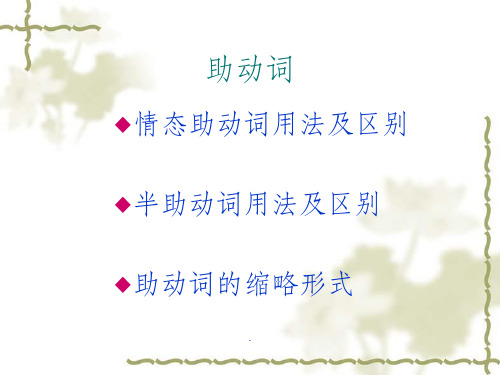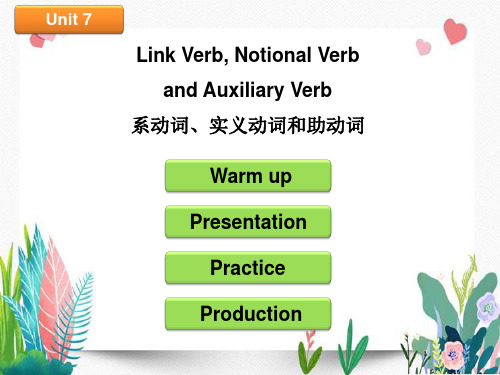助动词的ppt
合集下载
助动词

助动词
英语语法
01 定义
03 作用
目录
02 分类 04 具体用法
协助主要动词构成谓语的词叫助动词(Auxiliary Verb),也叫辅助动词。被协助的动词称作主要动词 (Main Verb)。助动词用来构成时态和语态。助动词具有语法意义,但除情态助动词外没有词汇意义,不可单 独作谓语。它没有对应的汉译,例如: He doesn't like English.他不喜欢英语。(does是助动词,无词义; like是主要动词,有词义)
作用
助动词协助主要动词完成以下作用 助动词a.表示时态,例如: He is singing.他在唱歌。 He has gotten married.他已结婚。 b.表示语态,例如: He was sent to England.他被派往英国。 c.构成疑问句,例如: Do you like college life?你喜欢大学生活吗? Did you study English before you came here?你来这儿之前学过英语吗? d.与否定副词not合用,构成否定句,例如: I did not (=didn't )like him.我不喜欢他。
定义
最常用的助动词有:be, have/has, do/does/did, shall, should, will, would等。 助动词可以协助主要动词构成时态或者语态,也可构成疑问句和否定句,构成否定句时与否定副词not连用。
分类
半助动词 在功能上介于主动词和助动词之间的一类结构,称为半助动词。 常见的半助动词有: be to, be about to, be due to, be going to, be likely to, be meant to, be obliged to, be supposed to, be willing to, have to, seem to, be unable to, be unwilling to.等。 情态助动词 1.情态助动词包括will(would), shall(should), can(could), may(might), must, need to, dare to, ought to, used to, had better,有词汇意义,后接动词原形(没有to的不定式)。 2.情态助动词没有主语是第三人称单数时,词尾不加s。 如:She will come here.
英语语法
01 定义
03 作用
目录
02 分类 04 具体用法
协助主要动词构成谓语的词叫助动词(Auxiliary Verb),也叫辅助动词。被协助的动词称作主要动词 (Main Verb)。助动词用来构成时态和语态。助动词具有语法意义,但除情态助动词外没有词汇意义,不可单 独作谓语。它没有对应的汉译,例如: He doesn't like English.他不喜欢英语。(does是助动词,无词义; like是主要动词,有词义)
作用
助动词协助主要动词完成以下作用 助动词a.表示时态,例如: He is singing.他在唱歌。 He has gotten married.他已结婚。 b.表示语态,例如: He was sent to England.他被派往英国。 c.构成疑问句,例如: Do you like college life?你喜欢大学生活吗? Did you study English before you came here?你来这儿之前学过英语吗? d.与否定副词not合用,构成否定句,例如: I did not (=didn't )like him.我不喜欢他。
定义
最常用的助动词有:be, have/has, do/does/did, shall, should, will, would等。 助动词可以协助主要动词构成时态或者语态,也可构成疑问句和否定句,构成否定句时与否定副词not连用。
分类
半助动词 在功能上介于主动词和助动词之间的一类结构,称为半助动词。 常见的半助动词有: be to, be about to, be due to, be going to, be likely to, be meant to, be obliged to, be supposed to, be willing to, have to, seem to, be unable to, be unwilling to.等。 情态助动词 1.情态助动词包括will(would), shall(should), can(could), may(might), must, need to, dare to, ought to, used to, had better,有词汇意义,后接动词原形(没有to的不定式)。 2.情态助动词没有主语是第三人称单数时,词尾不加s。 如:She will come here.
英语语法助动词

The window was broken by Tom.
English is taught throughout the world. 3)be + 动词不定式,可表示最近、未来的计划或安 排。如: He is to go to New York next week. We are to teach the fresh persons.
He might have fallen ill if he hadn’t take the medicine. 他如果没服药可能就病倒了 (2)表允许,多用于肯定句和疑问句,正式场合 You may take the book home。 .你可以把这本书带回家。 May I borrow your bicycle? 我可以借你的自行车吗? Might 表允许时比may更有礼貌。 Might I have a little brandy? 我可以喝一点白兰地吗?
助动词
什么是助动词?
协助主要动词构成谓语动词词组的词叫助 动词(Auxiliary Verb)。被协助的动词称 作主要动词(Main Verb)。 助动词自身没有词义,不可单独使用。如: He doesn't like English.他不喜欢英语。 (doesn't是助动词,无词义;like是主要 动词,有词义)
He may find the book at the library.
Can he find the book at the loibrary?
He can’t find the book at the library. b) might 和could 后跟不定时完成时表示过去未实现
的动作。
He might have found the book at the library. 他可以在图书馆找到这本书就好了(实际未找到)。
English is taught throughout the world. 3)be + 动词不定式,可表示最近、未来的计划或安 排。如: He is to go to New York next week. We are to teach the fresh persons.
He might have fallen ill if he hadn’t take the medicine. 他如果没服药可能就病倒了 (2)表允许,多用于肯定句和疑问句,正式场合 You may take the book home。 .你可以把这本书带回家。 May I borrow your bicycle? 我可以借你的自行车吗? Might 表允许时比may更有礼貌。 Might I have a little brandy? 我可以喝一点白兰地吗?
助动词
什么是助动词?
协助主要动词构成谓语动词词组的词叫助 动词(Auxiliary Verb)。被协助的动词称 作主要动词(Main Verb)。 助动词自身没有词义,不可单独使用。如: He doesn't like English.他不喜欢英语。 (doesn't是助动词,无词义;like是主要 动词,有词义)
He may find the book at the library.
Can he find the book at the loibrary?
He can’t find the book at the library. b) might 和could 后跟不定时完成时表示过去未实现
的动作。
He might have found the book at the library. 他可以在图书馆找到这本书就好了(实际未找到)。
助动词PPT课件

一加二改三问号
23
Do exercises.
1.There is some water in the cup. 2.They are teachers. 3.I am working with numbers. 4.Lisa can make a kite. 5.She does homework every night. 6.They like swimming.
2
TWhhisatis’stishawtithsdhiaiscs?tt.?.ionary. 一找:对物体进行提问用what 二代:用what代替划线部分 三移:把what放在句首 四变:把this is 变为一般疑问句
3
TWhheajtacokleotristishwretehdjea. ctjakcceoktloeistr.?. 一找:对颜色进行提问用what color 二代:用what color代替划线部分 三移:把what color放在句首 四变:把the jacket is 变为一般疑问句
一找:对年龄进行提问用How old 二代:用how old代替划线部分 三移:把how old放在句首
四变:把the boy is变为一般疑问句
6
• 关于特殊疑问词组
• 针对人提问 (谁)
who
• 地点(何地) where
• 时间(何时)
when what time
• 方式方法程序(怎样) how
4
TWhheebroe’ortakherseethabtaehroreobekwobusohnkaoesdkrr?ese?.r. the bed. 一找:对地点进行提问用where 二代:用where代替划线部分 三移:把where放在句首 四变:把the books are变为一般疑问句
23
Do exercises.
1.There is some water in the cup. 2.They are teachers. 3.I am working with numbers. 4.Lisa can make a kite. 5.She does homework every night. 6.They like swimming.
2
TWhhisatis’stishawtithsdhiaiscs?tt.?.ionary. 一找:对物体进行提问用what 二代:用what代替划线部分 三移:把what放在句首 四变:把this is 变为一般疑问句
3
TWhheajtacokleotristishwretehdjea. ctjakcceoktloeistr.?. 一找:对颜色进行提问用what color 二代:用what color代替划线部分 三移:把what color放在句首 四变:把the jacket is 变为一般疑问句
一找:对年龄进行提问用How old 二代:用how old代替划线部分 三移:把how old放在句首
四变:把the boy is变为一般疑问句
6
• 关于特殊疑问词组
• 针对人提问 (谁)
who
• 地点(何地) where
• 时间(何时)
when what time
• 方式方法程序(怎样) how
4
TWhheebroe’ortakherseethabtaehroreobekwobusohnkaoesdkrr?ese?.r. the bed. 一找:对地点进行提问用where 二代:用where代替划线部分 三移:把where放在句首 四变:把the books are变为一般疑问句
英语语法--助动词ppt课件

借钱给他还不如把钱扔到海里。
❖注意:
❖ (1)may/might比较
表推测时,might比may更不. 确定。 表允许时,might比may更有礼貌。
❖ (2)might may can could比较 a) may和can表可观可能和允许时意义相同,但是也
不能随意互换。表可观可能时 ,may仅用于肯定 句而can可用于各种句式。
.
❖ (3)表允许用于非正式场合。
Can在肯定疑问句中表要求在否定句中表禁止。
You can smoke in the entrance hall. Can you lend me 2yuan? Could 用于这个意义时只用于疑问句,语气更加委婉。
Could you please fetch us a few cups? ❖ (4)表感情色彩。表某种情绪。 What can satisfied her?(不满) What else can you say?(不耐烦) How can I do such a thing ?(难办)
他有时会很骄傲
.
2 may与might
(1)表示可以做或可能发生的事 He may come soon. You may order a taxi by telephone.
Might用于间接引语;也表客观未实现的动作 He said he might order a taxi by telephone. 他说他可以用电话定出租车。 He might have fallen ill if he hadn’t take the medicine. 他如果没服药可能就病倒了 (2)表允许,多用于肯定句和疑问句,正式场合 You may take the book home。 .你可以把这本书带回家。 May I borrow your bicycle? 我可以借你的自行车吗? Might 表允许时比may更有礼貌。 Might I have a little brandy? . 我可以喝一点白兰地吗?
❖注意:
❖ (1)may/might比较
表推测时,might比may更不. 确定。 表允许时,might比may更有礼貌。
❖ (2)might may can could比较 a) may和can表可观可能和允许时意义相同,但是也
不能随意互换。表可观可能时 ,may仅用于肯定 句而can可用于各种句式。
.
❖ (3)表允许用于非正式场合。
Can在肯定疑问句中表要求在否定句中表禁止。
You can smoke in the entrance hall. Can you lend me 2yuan? Could 用于这个意义时只用于疑问句,语气更加委婉。
Could you please fetch us a few cups? ❖ (4)表感情色彩。表某种情绪。 What can satisfied her?(不满) What else can you say?(不耐烦) How can I do such a thing ?(难办)
他有时会很骄傲
.
2 may与might
(1)表示可以做或可能发生的事 He may come soon. You may order a taxi by telephone.
Might用于间接引语;也表客观未实现的动作 He said he might order a taxi by telephone. 他说他可以用电话定出租车。 He might have fallen ill if he hadn’t take the medicine. 他如果没服药可能就病倒了 (2)表允许,多用于肯定句和疑问句,正式场合 You may take the book home。 .你可以把这本书带回家。 May I borrow your bicycle? 我可以借你的自行车吗? Might 表允许时比may更有礼貌。 Might I have a little brandy? . 我可以喝一点白兰地吗?
小学英语小学英语语法课件-系动词、实义动词和助动词 (共30张PPT) 全国通用

否定句:
主语+助动词do/does+not+实义动 I don’t like fruit.
词原形+其他
主语+主动动词not+动词形式+其他 He won’t go fishing.
句 型 结 构
一般疑问句:
助动词Do/Does+主语+实义动词原 形+其他? 助动词+主语+动词形式+其他?
Do you like fruit? Have you ever read this book?
Practice Oral Practice
— ____D_id_____ your brother go shopping last night? — No, he ____d_i_d____ (do) his homework at home. I ___h_a_v_e___ ____b_e_e_n____ (be) to Disney twice.
Presentation Grammar Box
系动词be的句型结构
肯定句:主语+系动词be+其他 He is a police officer. 他是一名警察。
句 否定句:主语+be+not+其他 型
He is not a police officer. 他不是警察。
结 一般疑问句:Be+主语+其他? Is he a police officer?
_tr_a__n_s_f_e__r,__b_e__c_a_m__e__________________________________ 助动词:_w_i_ll_, _h_a_v_e_n_’t_,_s_h_o_u_l_d_,_d_o_e_s_,_d_i_d_n_’t_____________
助动词讲解课件。PPT

4. will, shall (would, should) “will (shall+动词原形”构成一般将来时, 一般来说shall用于第一人称,will用于第 二人称或第三人称,口语中常用will代替 shall, 如We will have a meeting to discuss the problem.
3、do (does, did) (1)“do not + 动词原形”构成行为动词的 否定式。 (2)“Do + 主语 + 动词原形”构成行为动 词的一般疑问句。Does he go to school by bike every day? (3)“do + 动词原形”用于祈使句或陈述句 中表示加强语气。如:I did go to see him, but he wasn‟t in. (4)代替前面刚出现的动词以避免重复。 My mother told me to go to bed early. So I did.
2、have (has, had) (1)“have+过去分词”构成完成时态。 如:Have you seen the film ? (2)“have been + -ing”构成完成进行时态。 如:What have you been doing these days? 这些日子你一直在干什么?
助动词
定义:英语中用来构成一定的时态和语态,构成 否定、疑问及加强语气的词.助动词有be, have, do, will, shall。它们本身没有词义,只和实义动 词的一定形式构成复合谓语。 1、be (am, is, are, were, been) (l) “be + -ing”构成进行时态; (2) “be + 过去分词”构成被动语态; (3)“be + 动词不定式”构成复合谓语: ①表示按计划安排要发生的事。 The prime minister is to visit Japan next year. 总理将于明年访问日本。 ② 用于命令。You„re to do your homework before you watch TV.你得做完作业才能看电视
初中英语语法-助动词-PPT课件-图文

1. I like swimming in the summer. (do ) 2. You want to go shopping in the evening. (do) 3. He goes to work by car every day. (does) 4. We need some rice for lunch. (do) 5. They know the answer to the question. (do) 6. He spent a day painting the house. (did)
句式变化: 肯定句 否定句
变化规则 1.看 主语 确人称 2.找 动词 确时态 3.借 助动词 助动词后加“not” 4.变 原型 ( 助动词后跟 动词原形)
1. I like swimming in the summer. 2. You want to go shopping in the evening. 3. He goes to work by car every day. 4. We need some rice for lunch. 5. They know the answer to the question. 6. He spent a day painting the house.
谢谢!
2. You don’t want to go shopping in the evening.
3. He doesn’t go to work by car every day.
4. We don’t need some rice for lunch.
1. I like swimming in the summer. (do ) 2. You want to go shopping in the evening. (do) 3. He goes to work by car every day. (does) 4. We need some rice for lunch. (do) 5. They know the answer to the question. (do) 6. He spent a day painting the house. (did)
英语语法助动词

realize the importance of English. 只有在开始大学生活时我们才认识到英 语的重要性。
说明:引导此类倒装句的副词有never, seldom, rarely, little, 精o品nPlPyT, so, well等。
6)用作代动词,例如: — Do you like Beijing? — Yes, I do. (do用作代动词,代替like Beijing.) He knows how to drive a car,
意思 ,并可表示一次性动作。 I don’t swim so often as I used to. 我不想过去那样长游泳了。
精品PPT
4.shall与should
❖ shall的用法 Shall除在一般将来时中用于第一人称外,还有以下用法: 1. 表义务,用于第二三人称。如: You shall do as you see me do. 你照我做的样子做。
借钱给他还不如把钱扔到海里。 ❖ 注意:
❖ (1)may/might比较
表推测时,might比may更不确定。 表允许时,might比may更精有品P礼PT 貌。
❖ (2)might may can could比较 a) may和can表可观可能和允许时意义相同,但是也
不能随意互换。表可观可能时 ,may仅用于肯定 句而can可用于各种句式。
He might have fallen ill if he hadn’t take the medicine. 他如果没服药可能就病倒了 (2)表允许,多用于肯定句和疑问句,正式场合 You may take the book home。 .你可以把这本书带回家。 May I borrow your bicycle? 我可以借你的自行车吗? Might 表允许时比may更有礼貌。 Might I have a little brandy? 精品PPT 我可以喝一点白兰地吗?
说明:引导此类倒装句的副词有never, seldom, rarely, little, 精o品nPlPyT, so, well等。
6)用作代动词,例如: — Do you like Beijing? — Yes, I do. (do用作代动词,代替like Beijing.) He knows how to drive a car,
意思 ,并可表示一次性动作。 I don’t swim so often as I used to. 我不想过去那样长游泳了。
精品PPT
4.shall与should
❖ shall的用法 Shall除在一般将来时中用于第一人称外,还有以下用法: 1. 表义务,用于第二三人称。如: You shall do as you see me do. 你照我做的样子做。
借钱给他还不如把钱扔到海里。 ❖ 注意:
❖ (1)may/might比较
表推测时,might比may更不确定。 表允许时,might比may更精有品P礼PT 貌。
❖ (2)might may can could比较 a) may和can表可观可能和允许时意义相同,但是也
不能随意互换。表可观可能时 ,may仅用于肯定 句而can可用于各种句式。
He might have fallen ill if he hadn’t take the medicine. 他如果没服药可能就病倒了 (2)表允许,多用于肯定句和疑问句,正式场合 You may take the book home。 .你可以把这本书带回家。 May I borrow your bicycle? 我可以借你的自行车吗? Might 表允许时比may更有礼貌。 Might I have a little brandy? 精品PPT 我可以喝一点白兰地吗?
《be动词用法总结》课件

ERA
现在时的be动词形式和用法
形式
am, is, are
用法
表示当前存在的状态或正在进行的动作,用于一 般现在时态。
示例
I am a student. (我是一个学生。)
过去时的be动词形式和用法
形式
was, were
用法
表示过去存在的状态或过去发生的动作,用于一般过去时态。
示例
She was happy yesterday. (她昨天很开心。)
与现在事实相反的虚拟语气:在这种用法中,be动词的形式是“would+be”。例如,“If I were you, I would be very careful when crossing the street.”(如果我是你,我过马 路时会非常小心。)
被动语态中的be动词用法
被动语态是一种表达动作承受者 的语法结构,通常用于强调动作 的接受者而不是执行者。在被动 语态中,be动词用于构成被动语 态的形式,其后面跟着动词的过 去分词形式。
虚拟语气是一种特殊的语法结构,用于表达与事实相反的情况或假设。在虚拟语气中,be 动词的用法与一般时态不同。在虚拟语气中,be动词的形式主要有两种:与过去事实相反 的虚拟语气和与现在事实相反的虚拟语气。
与过去事实相反的虚拟语气:在这种用法中,be动词的形式是“would+have+been”。 例如,“If I had known the answer, I would have been able to pass the exam.”(如 果我早知道答案,我就会通过考试了。)
BIG DATA EMPOWERS TO CREATE A NEW ERA
05
Be动词的常见错误和注意事项
现在时的be动词形式和用法
形式
am, is, are
用法
表示当前存在的状态或正在进行的动作,用于一 般现在时态。
示例
I am a student. (我是一个学生。)
过去时的be动词形式和用法
形式
was, were
用法
表示过去存在的状态或过去发生的动作,用于一般过去时态。
示例
She was happy yesterday. (她昨天很开心。)
与现在事实相反的虚拟语气:在这种用法中,be动词的形式是“would+be”。例如,“If I were you, I would be very careful when crossing the street.”(如果我是你,我过马 路时会非常小心。)
被动语态中的be动词用法
被动语态是一种表达动作承受者 的语法结构,通常用于强调动作 的接受者而不是执行者。在被动 语态中,be动词用于构成被动语 态的形式,其后面跟着动词的过 去分词形式。
虚拟语气是一种特殊的语法结构,用于表达与事实相反的情况或假设。在虚拟语气中,be 动词的用法与一般时态不同。在虚拟语气中,be动词的形式主要有两种:与过去事实相反 的虚拟语气和与现在事实相反的虚拟语气。
与过去事实相反的虚拟语气:在这种用法中,be动词的形式是“would+have+been”。 例如,“If I had known the answer, I would have been able to pass the exam.”(如 果我早知道答案,我就会通过考试了。)
BIG DATA EMPOWERS TO CREATE A NEW ERA
05
Be动词的常见错误和注意事项
be动词课件

be动词课件
• be动词的概述 • be动词的基本形式 • be动词的用法 • be动词的常见错误 • be动词的练习与巩固 • be动词的总结与回顾
目录
01
be动词的概述
be动词的定义
基本定义
be动词是一种常见的动词,其基 本含义是表示存在、状态或关系 。
历史来源
be动词源于古英语,是英语中最 基本的动词之一。
表示位置
表示某人或某物在哪里, 例如:My keys are in the pocket. 我的钥匙在口 袋里。
表示变化和过程
表示变化
表示某人或某物发生了变化,例如:The fruit is ripe. 水果熟了。
表示过程
表示某个过程正在进行中,例如:The movie is playing. 电影正在播放。
此外,在某些语境下,也可以使用“be going to”来表示将 来时,如:It is going to rain. (将要下雨了。)
03
be动词的用法
表示存在、状态和位置
表示存在
表示某物或某人在某个地 方存在,例如:The book is on the table. 书在桌子 上。
表示状态
表示某人或某物的状态, 例如:She is hห้องสมุดไป่ตู้ppy. 她很 开心。
be动词的过去时形式
Be动词的过去时形式是“was”、 “were”。其中,“I”用“was” ,“you”用“were”, “he/she/it”用“was”。
Be动词的过去时形式用来表达过去的 状态,如:He was happy yesterday. (他昨天很开心。)
be动词的将来时形式
Be动词的将来时形式通常使用“will be”,用来表达未来的 状态,如:I will be a doctor. (我将成为一名医生。)
• be动词的概述 • be动词的基本形式 • be动词的用法 • be动词的常见错误 • be动词的练习与巩固 • be动词的总结与回顾
目录
01
be动词的概述
be动词的定义
基本定义
be动词是一种常见的动词,其基 本含义是表示存在、状态或关系 。
历史来源
be动词源于古英语,是英语中最 基本的动词之一。
表示位置
表示某人或某物在哪里, 例如:My keys are in the pocket. 我的钥匙在口 袋里。
表示变化和过程
表示变化
表示某人或某物发生了变化,例如:The fruit is ripe. 水果熟了。
表示过程
表示某个过程正在进行中,例如:The movie is playing. 电影正在播放。
此外,在某些语境下,也可以使用“be going to”来表示将 来时,如:It is going to rain. (将要下雨了。)
03
be动词的用法
表示存在、状态和位置
表示存在
表示某物或某人在某个地 方存在,例如:The book is on the table. 书在桌子 上。
表示状态
表示某人或某物的状态, 例如:She is hห้องสมุดไป่ตู้ppy. 她很 开心。
be动词的过去时形式
Be动词的过去时形式是“was”、 “were”。其中,“I”用“was” ,“you”用“were”, “he/she/it”用“was”。
Be动词的过去时形式用来表达过去的 状态,如:He was happy yesterday. (他昨天很开心。)
be动词的将来时形式
Be动词的将来时形式通常使用“will be”,用来表达未来的 状态,如:I will be a doctor. (我将成为一名医生。)
- 1、下载文档前请自行甄别文档内容的完整性,平台不提供额外的编辑、内容补充、找答案等附加服务。
- 2、"仅部分预览"的文档,不可在线预览部分如存在完整性等问题,可反馈申请退款(可完整预览的文档不适用该条件!)。
- 3、如文档侵犯您的权益,请联系客服反馈,我们会尽快为您处理(人工客服工作时间:9:00-18:30)。
b)与名词词组搭配 与名词词组搭配
Mary's coming tomorrow evening (=is) My friend's opened a new hotel (=has) The roads're good (=are) Anna'll be going to London (=will) The camera'd been stolen (=had) The book'd be useful (=would) The guests've all gone (=have)
d)与存在句引导词 与存在句引导词there搭配 与存在句引导词 搭配
There's a lot to do (=has) There've been many accidents at this corner There'll be a new film next week . (=will) She wondered if there'd been a mistake (had) He thought there'd be an answer by tomorrow (=would) 地点副词here/there也常与's(=is)搭配.例如: Here's your bicycle and there's mine.
2)肯定缩略形式 肯定缩略形式
上述24个限定动词只有以下10个能有肯 定缩略形式:
am is are have has had shall will should would
下面介绍一下肯定形式与其他词语常见 的搭配现象:
a)与人称代词搭配 与人称代词搭配
I'm a student. (=I am) It's raining. (=It is ) She's been away for months. (=She has) We'd stay in this hotel if it was cheaper (=would) We'd have come if you'd asked us (=should , had ) 注意区分it's 和its :The cat is licking its tail;it's not licking its paw. 's 既可以is 也可以表示has . 'd既可以表示should ,would ,也可以表示had ,需 从上下文进行判断。
NO.6(1994) He____ the 8:20 bus because he didn’t leave home till 8:25. A. couldn’t have caught B. ought to have caught C. shouldn’t have caught D. must not have caught
1)否定缩略形式 否定缩略形式(2) 否定缩略形式
有些否定句式能有两种缩略形式。例如: she isn't coming here alone. she's not coming here alone. 否定疑问句既能用否定缩略形式,也能用非缩 略形式。试比较: Haven't we seen this film before ? Have we not seen this film before ? 但含义有所不同:用否定缩略形式通常带有肯定 与否定双重意向;用非缩略否定形式通常带有 否定意向。(参见27.2.1)
18.2 助动词的缩略形式
英语有以下24个助动词能有缩略形式: am , is , are , was , were , have , has , had do , does , did , shall , should , will , would can , could , may , might , must , ought(to) need , dare , used(to)
18.1 半助动词
半助动词指在功能上介乎主动词和助动 词之间、本身带有词义的一类结构。下 面就半助动词的类型以及半助动词与 it...that结构的转换关系作一些介绍。
1)半助动词的类型(1) )半助动词的类型
从形态上看,可以分成三类: 以be为其中心成分; 以have为中心成分; 以seem等为其中心成分。 从能否与it...that结构进行转换上看又 可以分为能与不能两类 (p210-211 表 格)
c)与指示代词、不定代词、物主代词 与指示代词、不定代词、 与指示代词 搭配
That's fine (=is) This'll do (=will) That'd be much better (=would) Someting's got to be done (=has) Mine's blue ;yours is red (=is)
3)非缩略形式的使用场合 非缩略形式的使用场合(1) 非缩略形式的使用场合
上述能用于肯定缩略形式的10个限定动词,在下 列场合不能采用缩略形式:
a)单独使用时 单独使用时
A: You've seen her,haven't you? B: Yes, I have . (≠ I've)
b)用于句子结尾时 用
A: You're not coming with me. B: I am coming whether you like it or not. (≠ I'm)
e)Have/have to作“有”/“必须”解释时通 作 “必须” 常也不用缩略形式
They have three children . (≠ They've) He has to leave early (≠ He's to)
e)与疑问词搭配 与疑问词搭配
How's your father? (=is) What're you doing? (=are) Where've they gone to? (=have) Who'd have believed it? (=would) What'll you have to drink? (=will)
若改用have got/have got to形式表示,则常 用缩略形式:They've got three children. He's got to leave early .
NO.1(TEM4 2004) You ____Jim anything about it. It was none of his business. A . needn’t have told B . needn’t tell C . mustn’t have told D. mustn’t tell
1)否定缩略形式 否定缩略形式(1) 否定缩略形式
上述24个限定动词除去am not 的疑问形式需要 用aren't替代外,其余23个都有各自的否定缩略 形式。例如: am not , don't , couldn't , aren't , usedn't , daren't 等 在句子中例如: I'm late , aren't I? They won't be here next week . You shouldn't smoke so much . They mayn't like it . 等等
John's not such a good student as Bill is (≠ Bill's)
c)用于发问或附加疑问时 用于发问或附加疑问时
Will he come You haven't seen her , have you ?
3)非缩略形式的使用场合 非缩略形式的使用场合(2) 非缩略形式的使用场合
NO.7(92) A hibernating animal needs hardly any food all through the winter,_____? A. need it B. needn’t it C. does it D. doesn’t it
NO.8(97) When you have finished with that video tape , don’t forget to put it in my drawer,_____? A. do you B. will you C. don’t you D. won’t you Do you help yourself to some fruit , _____ you? A. can’t B. don’t C. wouldn’t D. won’t
第18讲 助动词 (Auxiliary) 18讲
Forewrd
英语的助动词分为三类:基本助动词 (Primary Auxiliary)、情态助动词 (Modal Auxiliary)和半助动词(Semiauxiliary)。 本讲将介绍的是半助动词(Semiauxiliary)以及助动词(Auxiliary)的 缩略形式(Contracted Form)。
NO.2(TEM4 1999) He _____unwisely, but he was at least to do something helpful. A . may have acted B . must have acted C . should act D . would act
NO.3 ____he come late , give him the message. A . Had B. Should C . Would D . If
NO. 4(TEM 1996) Western Nebraska generally receives less snow than _____Eastern Nebraska. A. in B. it receives in C. does D. it does in
